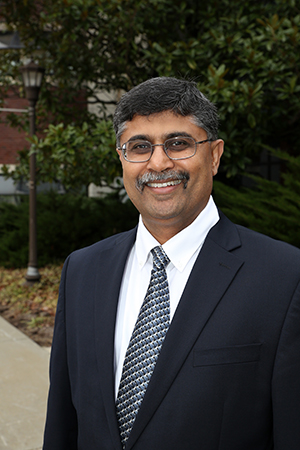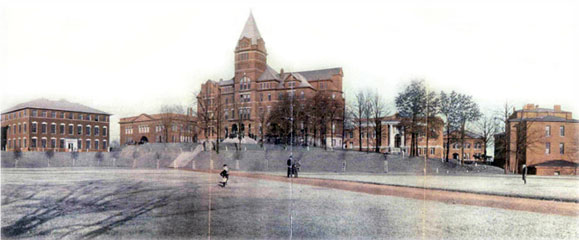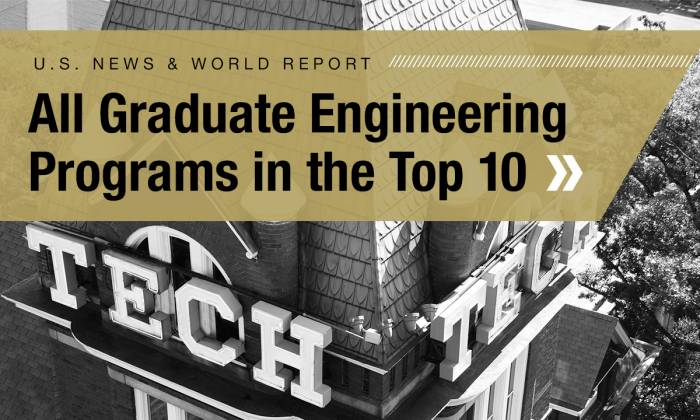A Message from the School Chair
 Welcome to the George W. Woodruff School of Mechanical Engineering at Georgia Tech. I am excited, humbled, and honored to serve as the Interim Eugene C. Gwaltney, Jr. School Chair.
Welcome to the George W. Woodruff School of Mechanical Engineering at Georgia Tech. I am excited, humbled, and honored to serve as the Interim Eugene C. Gwaltney, Jr. School Chair.
The Woodruff School is an inclusive, innovative, and thriving educational and research environment committed to fostering the next generation of intellectually curious and globally engaged leaders who are empowered to create solutions to society’s most challenging problems and dedicated to improving the human condition.
We are proud to house a robust Nuclear and Radiological Engineering and Medical Physics program in the Woodruff School. The depth and breadth of our mechanical engineering and nuclear and radiological engineering programs have led to national rankings that place us in elite company. Our mechanical engineering undergraduate program is second according to U.S. News & World Report, while we rank fifth in our graduate mechanical engineering program and ninth in nuclear engineering.
With nearly 3,000 students, more than 100 faculty, and over 80 staff members we’re a big and diverse school. We pride ourselves on being a leading producer of graduate degrees for women and minorities in the U.S. and strongly believe in encouraging experiential learning activities in all of our programs.
At the undergraduate level, 20% of our students are involved in research annually, 50% spend a semester studying abroad, and 60% engage in a co-op or internship prior to graduation. In addition, our students have access to the largest student-run makerspace in the nation, the Flowers Invention Studio; can participate in one of our seven Student Competition Center teams such as Wreck Racing, GT Off-Road, or RoboJackets; have the opportunity to take on a leadership role in organizations like the American Nuclear Society (ANS) or the American Society of Mechanical Engineers (ASME); and can explore entrepreneurship through entering the InVenture Prize or taking part in CREATE-X, a Georgia Tech initiative to instill entrepreneurial confidence in students and empower them to launch successful startups.
At the graduate level, we perform research across 14 different areas: Acoustics and Dynamics; AI, Informatics for ME (AI2ME); Automation, Robotics and Control; Bioengineering; CAE and Design; Engineering Education; Fluid Mechanics; Heat Transfer, Combustion, and Energy Systems; Manufacturing; Mechanics of Materials; Medical Physics; Micro & Nano Engineering; Nuclear and Radiological Engineering; and Tribology. We currently exceed $60 million in new research awards annually which provides for a rich set of research opportunities in world-class facilities at Georgia Tech, like the Artificial Intelligence Manufacturing Pilot Facility (AI-MPF). The Woodruff School also plays a strong role in several Interdisciplinary Research Institutes on campus including the Georgia Tech Manufacturing Institute, the Institute for Data Engineering and Science, the Parker H. Petit Institute for Bioengineering and Bioscience, and the Strategic Energy Institute. Finally, we have strategic partnerships with several Department of Energy National Laboratories that give our graduate students unique research opportunities.
Over the last few years, we've launched various new programs and initiatives that have been essential in helping us maintain our tradition of excellence and provide the best possible environment for our students and faculty to thrive. In 2022, we introduced Woodruff Strong, one of the School’s top priorities during the comprehensive campaign, Transforming Tomorrow: The Campaign for Georgia Tech. Through the program, the School seeks to fundraise for scholarships and fellowships, academic support services, and health and wellness resources. Shortly after, we selected 20 inaugural members to join the newly established Woodruff Young Alumni Council (YAC). The Council's goal is to increase engagement among mechanical engineering and nuclear and radiological engineering students and recent graduates by providing targeted professional development, amplifying entrepreneurial impact, and enhancing the student and young alumni experience. In 2024, we hosted an inaugural STEM immersion and mentoring program, GT PRIME, developed for school counselors and K-12 students in the community. Most recently, and in collaboration with the colleges of engineering, business, and design, we launched TechMade to give Georgia Tech students hands-on exposure to the full sweep of product realization, from design to manufacturing, no matter their major.
All of our success wouldn’t be possible without outstanding members of the Woodruff School community. We are inspired by and grateful for the ongoing contributions and commitment that propels us to execute our mission and achieve our vision. We invite you to explore our website to learn more about how we are strengthening our impact locally, nationally, and globally as we achieve a culture of Inclusive Excellence.
Best regards,
Shreyes N. Melkote
Interim Eugene C. Gwaltney, Jr. School Chair
schoolchair@me.gatech.edu

The first degree offered at the Georgia School of Technology, as the Institute was then called, was the Bachelor of Science in Mechanical Engineering. Today, the George W. Woodruff School of Mechanical Engineering offers three bachelor of science degrees, six master of science degrees, and two doctor of philosophy degrees.
A Brief History of Georgia Tech and the Woodruff School
A school of technology was established in Atlanta in 1885. In October 1888 the Georgia School of Technology opened its doors and admitted its first engineering class: 129 mechanical engineering students enrolled in Tech's first degree program. As part of their education these early students worked at trades such as forging, woodworking, machining, and mechanical drawing. The products of these shop exercises were then sold to the public to produce income for the School.
The first Head (starting in 1888) and Professor of Mechanical Engineering was John Saylor Coon, a graduate of Cornell University and a charter member of the American Society of Mechanical Engineers. He held this position for 35 years until his retirement in 1923.
Over the years, the mechanical engineering program expanded and changed. By 1896, the contract system of shops had been abandoned. Free from the need to render a profit on instructional time, Dr. Coon implemented an educational format which, while it retained elements of hands-on shop training, placed more stress on the emerging tenets of quantification and analysis. Dr. Coon revised the curriculum, describing a mechanical engineering program that emphasized design, mathematics, and problem solving. Prominent here was a senior thesis, which was an experimental laboratory project emphasizing design and testing. The experimental project requirement survives today as the capstone experimental engineering course.
The notion that an engineer was a technical master first and a businessman second permeated the curriculum of Georgia Tech at the turn of the century. Mechanical engineering students conducted efficiency tests for businesses in Atlanta and experiments using campus facilities. Practical projects at local businesses became a significant part of the educational process at Georgia Tech, especially after the Cooperative Program officially began in 1912. This continues to be the largest optional program of its kind in the country. About forty percent of all mechanical engineering undergraduate students at Georgia Tech are involved in the program. In addition, there is a Graduate Co-op Program, an International Co-op Program, an Undergraduate Professional Internship Program, and a number of study-abroad programs for students to gain international experience.
Tech graduated its first two students, with bachelor's degrees in mechanical engineering, in 1890. The first MSME was authorized in 1922, and a doctoral program was added in 1946. The first MS degrees were awarded in 1925, and the first Ph.D.'s were granted in 1950. Georgia Tech was renamed the Georgia Institute of Technology in 1948. Women were admitted in 1952, and the campus was voluntarily integrated in 1962. In 1949, the Department of Mechanical Engineering officially became the School of Mechanical Engineering with its own director and administrative staff. In 1985 the School was named for its benefactor, distinguished Atlanta business and civic leader, the late George W. Woodruff (class of 1917).
In 2000, the American Society of Mechanical Engineers recognized the Woodruff School as a Mechanical Engineering Heritage Site. Of the 225 landmarks, sites, and collections, we are the only educational institution with this honor, which was granted for the impact that mechanical engineering education at Georgia Tech had on the South and the nation.
Graduates from Georgia Tech have always had a hand in helping build industry in the South. This is as true today as it was when Georgia Tech was opened in 1888 and began to educate engineers and revitalize the economy of the South, devastated after the Civil War. Today's rigorous engineering curriculum allows our students to continue to have a lasting impact on the global society.
Faculty
We have over 100 full-time, tenure-track faculty (all with Ph.D.'s), including 36 adjunct appointments from other schools on campus. There are also 57 research faculty and 8 academic professionals to support research and teaching.
- 30 senior faculty members hold endowed chairs, fellowships or distinguished professorships.
- 35 faculty members have received prestigious Faculty Early Career Awards.
- 6 National Academy of Engineering (NAE) members including emeritus and adjunct appointments.
The faculty in mechanical engineering is divided into 13 self-selected research areas: Acoustics and Dynamics; Artificial Intelligence and Informatics for Mechanical Engineering; Automation and Mechatronics; Bioengineering; Computer-Aided Engineering and Design; Fluid Mechanics; Heat Transfer, Combustion, and Energy Systems; Manufacturing; Mechanics of Materials; Medical Physics; Micro & Nano Engineering; Nuclear and Radiological Engineering; and Tribology.
Staff
- The faculty and students are supported by 72 professional staff members, including people who specialize in advising, communications, computing, electronics, finance, and machine shop.
- The School participates in a robust number of Georgia Tech co-op student opportunities that assist in supporting internal and external programs.
Students
From the summer 2019 to spring 2020, 898 degrees were awarded by the Woodruff School:
- 591 bachelor's degrees
- 245 master's degrees
- 62 Ph.D.'s
In fall 2020, the enrollment in the Woodruff School included 1,803 undergraduate students and 856 graduate students; of those 602 are women and 417 international students.
Woodruff School students participate in a rewarding, hands-on experience and belong to a number of highly successful groups that compete at the regional and national level:
- EcoCar
- GT Motorsports
- GT Off-Road
- HyTech Racing
- RoboJackets
- Solar Jackets
- Wreck Racing
Professional organizations with student chapters include:
- American Association of Physicists in Medicine (AAPM)
- American Nuclear Society (ANS)
- Acoustical Society of America (ASA)
- American Society of Heating, Refrigerating, and Air Conditioning Engineers (ASHRAE)
- American Society of Mechanical Engineers (ASME)
- Health Physics Society
- Pi Tau Sigma (Nu Chapter)
- Society of Automotive Engineers (SAE)
- Society of Manufacturing Engineers (SME)
There are organizations especially for graduate students. The Mechanical Engineering Graduate Student Association (MEGA) fosters identity and pride in mechanical engineering through service and social activities. And the Woodruff School Graduate Women (WSGW) serves the academic, social, and career needs of female graduate students.
Alumni
- More than a dozen Woodruff School Ph.D. alumni who are faculty members at other universities have won prestigious Faculty Early Career Awards.
- Approximately 20% of our graduating seniors go directly to graduate or professional school.
- Approximately 20% of our graduating Ph.D. students pursue academic careers with many others pursuing careers at national laboratories.
Facilities
J. Erskine Love Jr. Manufacturing Building
- 153,664 sq. ft
- Opened in 2000
- Building is shared with Materials Science and Engineering
- Underwater acoustics tank, wind tunnel, and MEMS clean room are special facilities
- Acoustics, Fluid Mechanics, Heat Transfer, and MEMS are the research groups in this building
Parker H. Petit Biotechnology Building
- Opened in 1999
- Bioengineering research group is located here
Fuller E. Callaway, Jr. Manufacturing Research Center
- 118,380 sq. ft.
- Opened in 1991
- Manufacturing, CAE/Design, and Automation/ Mechatronics faculty research groups are housed here
Manufacturing Related Disciplines Complex
- 121,976 sq. ft.
- Opened in 1995
- Building is shared with Materials Science and Engineering
- Undergraduate laboratories and Wepfer Design Commons are among the special facilities
- Tribology and Mechanics of Materials are research groups in this building
IPST Centennial Engineering Building
- Opened in 1997
- Faculty members in Paper Science and Engineering
Boggs Building (Nuclear and Radiological Engineering and Medical Physics)
- 41,432 sq. ft.
- Opened in 1963
- NREMP faculty offices, administration and research groups in: fission, fusion, and medical physics
Student Competition Center
- Moved to new location in 2011
- Houses various student competition groups, including GT Motorsports, GT Off-Road (the SAE-baja team), RoboJackets, Solar Jackets and Wreck Racing

